Ellison Family Fund and Buddhism Educational Opportunities Fund support scholar’s Nepali 3D imaging project
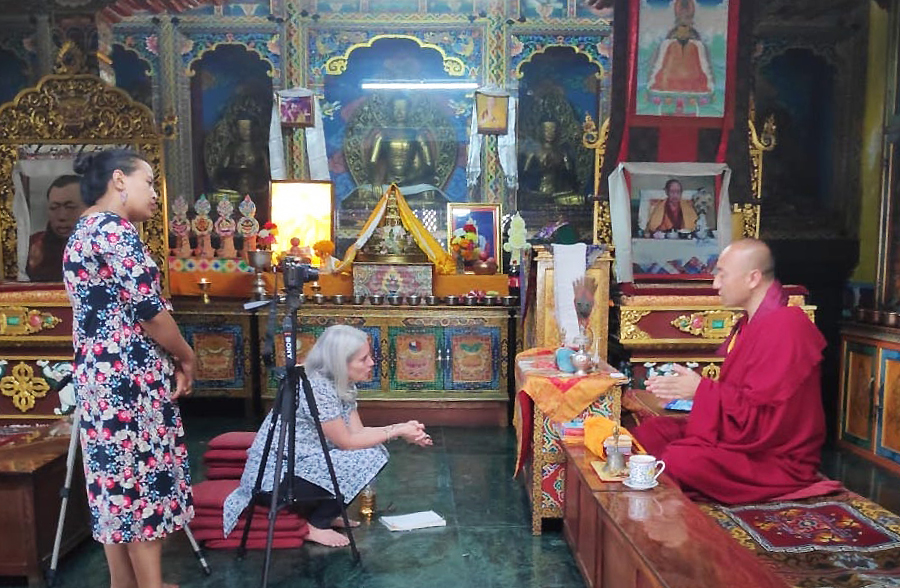
Leve and cultural heritage activist Alina Tamrakar interview the resident monk at Deva Dharma Mahavihar, a Buddhist monastery located in front of the stupa. (photo by Alok Tamrakar)
As an Ellison Family Faculty Fellow in the Institute for Arts and Humanities in spring 2019, Religious studies scholar Lauren Leve was given “a rare opportunity that came at a critical time for me professionally,” thanks to the Ellison Family Fellowship Fund established by John Gray Blount Ellison Jr. ’69 (MBA ’72), a long time supporter of the University.
“In just one semester, I made meaningful progress on three different projects,” said Leve. “I worked on a journal article that explored the growing number of women converting to Christianity in Nepal. I made huge progress on my monograph on the globalization of mindfulness meditation (vipassana) as exemplified in the lineage associated with Indian-Burmese businessman S.N. Goenka.”
“I also worked on a digital humanities project, creating 360-degree video and 3D virtual reality models of sacred Buddhist sites in the Himalayas for use in my teaching,” Leve explained. That work continued in 2022, when she partnered with a computer science class to create an annotated 3D model of Swayambhunath, an ancient holy site in Nepal’s Kathmandu Valley. The Buddhism Educational Opportunities Fund, created in 2017, was among a variety of funding sources that made this project possible.
3D imaging project brings Nepali sacred site to life
Leve, an expert in Himalayan Buddhism, was conducting research in Nepal in 2015 when a 7.8 magnitude earthquake hit, demolishing many cultural and religious monuments.
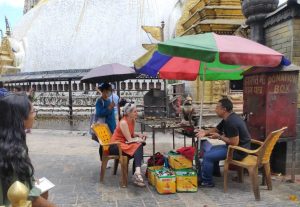
In all, about 9,000 people were killed as a result of the severe earthquake, and more than 600,000 structures in Kathmandu and nearby towns were damaged or destroyed.
“Architects and engineers were trying to reconstruct these monuments, and they didn’t have the information to do that at the precision that was needed,” said Leve, a UNC associate professor of religious studies who has been conducting research in Nepal for over 30 years. “Cultural preservationists were also concerned that knowledge about the monuments would be lost forever.”
Humanities meets tech
Several years later, when Leve attended a presentation by religious studies Ph.D. student Bradley Erickson on the 3D imaging work he was doing in Israel and Palestine, something clicked: Digitally capturing these Nepali holy sites could be not only an important teaching tool for her UNC students but also a valuable asset to the people of the Kathmandu Valley.
In 2018, Leve and Erickson received a UNC Innovation Grant, funded by Lenovo, to travel to Nepal and use 3D photogrammetry techniques to create intricate digital models of Buddhist sacred sites and objects that would allow students to virtually visit the spaces and locations Leve discussed in class. She also organized a free workshop to teach interested Nepalis how to use the technology to advance their own projects.
Attendees of the five-day Nepal workshop included cultural activists, engineers, conservationists, artists, journalists, a Tibetan Buddhist monk and even a woodcarver.
Once Leve returned to Chapel Hill, she began using the 3D models in her undergraduate courses through a website, “Visualizing Himalayan Buddhism.”
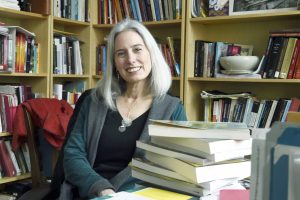
She said students often have an incomplete picture of Buddhism — they see it as a philosophy, an abstract set of ideas often expressed through silent meditation.
“Embodied practices such as pilgrimage, circumambulation and offerings are central to Buddhist insight and experience,” Leve and Erickson wrote in a chapter of The Oxford Handbook of Religious Space, published in July 2022.
“The explanations for all of the models are minimal on the website because I want students to encounter these sites themselves at first, without interpretation, and to think about what they are seeing and experiencing,” Leve said.
In one of her courses, Leve asks students to choose a particular object or feature of one of the 3D models and to create a description of it by researching scholarly resources. These descriptions are then added to the website as annotations.
End-of-semester comments from students have included “These [assignments] have really convinced me of another vital element of Tibetan Buddhism — location, community, belonging, images, objects, spaces … things that are physical,” and “This class made me think of religion as it’s practiced, not as it’s presented in texts.”
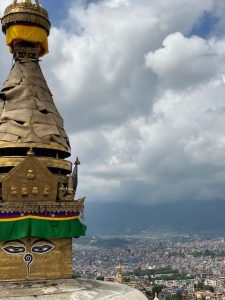
As she was using the models in her courses in Chapel Hill, participants from the Nepal workshop were pursuing their own projects. Her work and theirs came back together in the summer of 2022 when Leve returned to partner with heritage activists and Buddhist stakeholders to create a 3D model of Swayambhunath, one of the most ancient and important religious monuments in the Kathmandu Valley and a UNESCO world heritage site.
They also recorded interviews with Buddhist monks, priests, scholars and visitors to the temple to document cultural, spiritual and historical knowledge of the site. The team wanted to preserve both tangible (the structure itself) and intangible (cultural) heritage associated with the monument. Together, they selected interview excerpts to upload to the 3D model so that visitors could listen to audio while they explored the digital site.
The challenge was how to put it all together.
Through a listserv seeking project proposals, Leve found out about a UNC computer science course, “Software Engineering Lab,” taught by professor David Stotts. In the class, students take on real-world computer programming projects for clients. Leve submitted a proposal that was successful.
A team of four students was assigned to her project last fall with the goal of developing a prototype for an interactive, immersive 3D site that visitors could “walk through,” peppered with annotated interviews and descriptions. For instance, one text box explains that the Tibetan name for Swayambhunath translates to “sublime trees” because of the many varieties of trees found there.
“One of the most interesting things about the project for me is the minutiae of it and the learning curve required with the technology,” Leve said. “[As a scholar], it’s constantly making me think in new ways. It’s been really terrific working with the students.”
Emma Zhang, a senior computer science and biology major who is also pursuing a French minor, was the client lead on Leve’s project team. Her fellow team members included students Cong Lu, Yufei Dong and Sam Shi. The project title was “Visualizing Religion and Heritage in Nepal.”
“This was the only project that every single person on my team agreed upon,” Zhang said. “The most interesting conversation I had with Professor Leve was about the interaction between people in the sciences and the humanities and how we approach research differently and how to see from both perspectives.”
Students navigated the pluses and minuses of open-source software called Potree that they used to create the site. The final “proof of concept” renders a little bit fuzzy, Zhang noted, but she said she was proud of what students accomplished in the course of semester. She said she also learned about the importance of documentation and making tutorials for clients so that the project can be continued.
Next steps
Leve’s next step is to return to Nepal to create higher-quality images of the site using LiDAR technology. LiDAR, short for Light Detection and Ranging, is a remote sensing technology used to create high-resolution 3-D representations of larger surface areas.
“LiDAR would give us a level of precision that is otherwise very hard to achieve; it records accurate spatial coordinates and will stitch the images [of the Swayambhunath site] together more accurately and give us the kind of detail that material heritage preservation demands,” Leve said.
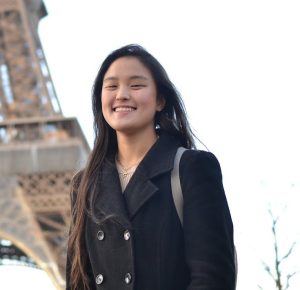
She will also continue to work on the intangible heritage part of the project in partnership with community stakeholders, collecting more stories and experiences from the people in Nepal who actively use the site. For instance, digital visitors might be able to click on a prayer wheel and hear a Buddhist artisan describe how he was taught to make the wheel in a family workshop. She’d also love to make the site both virtual reality-accessible and mobile-friendly.
Each time she returns to Nepal, Leve said she learns something new.
“Even after all these years, it’s like being dropped into a fully embodied educational experience that challenges everything I know and the way I think about the world,” she said. “I become a better person and a better teacher by being confronted with these things that challenge me.”
Zhang, who will head to a job in private equity after graduation this May, said working on the Nepal project will be a highlight of her time on campus.
“Carolina gives you these amazing opportunities to do interdisciplinary work, and the work that I’ve found the most meaningful and valuable and that helps guide the choices that I make on a daily basis has been in these types of classes,” Zhang said. “I really do think a liberal arts education is an amazing thing.”
A version of this story appeared in January 2023 on the College of Arts and Science website.

